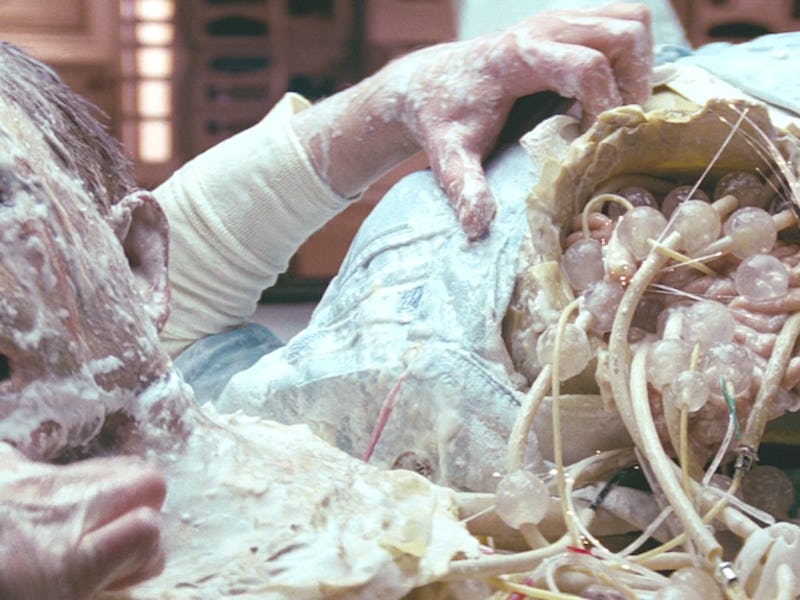3 Theories Explaining Why Robots Bleed
Science fiction meets technological reality in a puddle of goop.

As robots become more sophisticated, the dual definitions of artificial and human life have become increasingly fluid. With the release of Westworld, HBO will make those distinctions — already divisive in the scientific and hard science fiction-loving communities — even murkier. How will the show do this? By humanizing robots and dehumanizing everyone else. Also by pouring out a lot of “robot blood,” a classic science fiction trope designed to confound mechanical expectations. But why does the idea of bleeding automatons resonate? Partially because it seems realistic and partially because it doesn’t.
Here are three theories on why robots keep bleeding.
1) Robots Are Complex Machines, Which Often Require Fluid
In 2003, NASA experimented with magnetized fluids that would allow robots to move in a more life-like fashion. The “MR fluids,” which were based on the same material that can be found in the shock absorbers of sports cars or buildings fortified from the shock of an earthquake, had the potential to provide robots with a life-like nervous system.
In recent years, MR fluids have been utilized to create “human safe” robots that could work alongside humans with increased efficiency and a decreased risk of injury. Providing robots with a capable nervous system would work alongside A.I. to make the machines not just intellectually human-like, but physically as well. Researchers in Japan have already developed artificial multifilament muscles that work precisely like the human muscular system.
2) Robots Can Be Made With Circulatory Systems
The most robust debate about robot blood rests not in the scientific community, but in the world of video games. Players of the game “Fallout” in particular are divided over what the visual effects associated with the murder of a robot mean. Is that red substance machine fluid or A-positive? The most plausible theory making the rounds on Reddit credits the visual to “Old World Blues,” where users are allowed to splice a human brain with a robot, creating a “robobrain.”
While the concept of using “robobrains” might seem a bit of a stretch, the idea of using organic versus synthetic parts to power robots isn’t as crazy as it sounds. Harvard scientists have genetically mutated rat cells modified to react to light pulses, subsequently stimulating robotic stingray fins. And we do have spliced robots. Medical tools like synthetic cadavers can begin to show us what it would look like for a robot to actually have human parts.
3) We Need Robots to Bleed for Psychological Reasons
Robot blood might ultimately be tied more to our perceptions of their humanity than actual science. Yes, in the case of those in Westworld it might make them more pleasant to fuck, but there’s no mechanical reason. Rather, a human-like appearance invokes a strong psychological reaction in humans. In entertainment, it gives us the same feelings of horror (and possibly gratification) that the murder of a human does. Last year Japanese researchers found the first neurophysiological evidence of human ability to empathize with robots — in fact, even when subjects reported that they did not perceive that robots received pain, EEG scans showed a response indicating they did.
According to researcher Adriana Hamacher, “even the slightest expression of human emotion” can make humans more empathetic towards robots. In a recent study presented at IEEE International Symposium on Robot and Human Interactive Communication, Hamacher and other researchers found that in low-pressure situations people preferred expressive humanoid robots to less communicative ones. Research shows that people anthropomorphize inanimate objects, and robots are no exception. But it’s still unclear which human behaviors (or biology) designers should actually be focusing on.
“Research is still working on which human-like qualities we should be looking at, and there’s risk we could be focusing on the wrong one,” Hamacher tells Inverse. Robots are designed by humans, and designer biases can slip into product creation.
Of course, if designers take things too far, there’s a risk of “Uncanny Valley,” a sociological term for the disturbing nature of an object that is just too humanlike. It’s still unclear what the perfect balance of human behavior and human appearance would be for a robot — hence, the nefarious outcomes of science fiction like Westworld, where robots turn on their human creators.